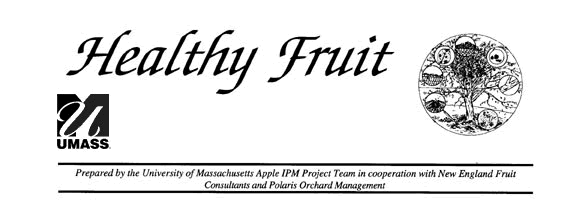
|
|
|---|
Sooty blotch (SB) and Flyspeck (FS) are showing up on several cultivars: 'Jersey Mac', 'Mac', 'Gala', 'Jonagold', and 'Empire'. The first incidence noted by the UMASS IPM team was 7/31, earlier than usual (some years it doesn't show up until the end of August). Most of the observed flyspeck has been on trees that have been unsprayed since June 15, but there have been a few sprayed blocks with a low level of flyspeck (1-3%) already.
One of the flyspeck prediction models being studied and developed at UMASS reached 220 hours of accumulated leaf wetness with adjustments for temperature during the last week of July in Western MA, the beginning of August in Central MA, and is most likely at that point now for Eastern MA. An older model, which does not track temperature, indicated that the 220 hours of accumulated wetness, which corresponds to first incidence, happened about a week earlier at the various sites. It is very early in the game but it looks like the newer model may work better for New England growers. We should credit Glen Koehler of Univ. of Maine Coop. Extension for the temperature adjustment mechanism.
The implications for late-ripening and lightly-colored cultivars this year are not good, especially considering the continued rain. Remember last year with a long drought and no flyspeck showing up anywhere until the end of August? It was very tempting to just stop spraying fungicide, but people who had late cultivars got nailed with summer disease right after the hurricane in September. This year, growers should continue coverage on late cultivars even as they are harvesting early varieties if they can possibly fit it in. Typical sprays that are good for summer diseases, i.e., captan or the new strobilurins (Flint or Sovran) will be effective with scab as well. If scab is a big problem, add Benlate to the captan (but remember the 14 day pre-harvest interval for Benlate and the Flint! Sovran probably is 14 days PHI too.)
Healthy Fruit is written by Dan Cooley, Ron Prokopy, Jon Clements, Starker Wright, Arthur Tuttle, Wes Autio, Bill Coli, and Duane Greene except where other contributors are noted. Publication is funded in part by the UMass Extension Agroecology Program, grower subscriptions, and the University of Massachusetts IPM Program. A text version can be e-mailed to you if you contact Doreen York. Please cite this source if reprinting information.
Go to the UMass Extension Main Page
Return to the UMass Fruit Advisor Main Page
Return to the Healthy Fruit Index Page